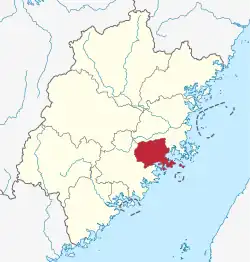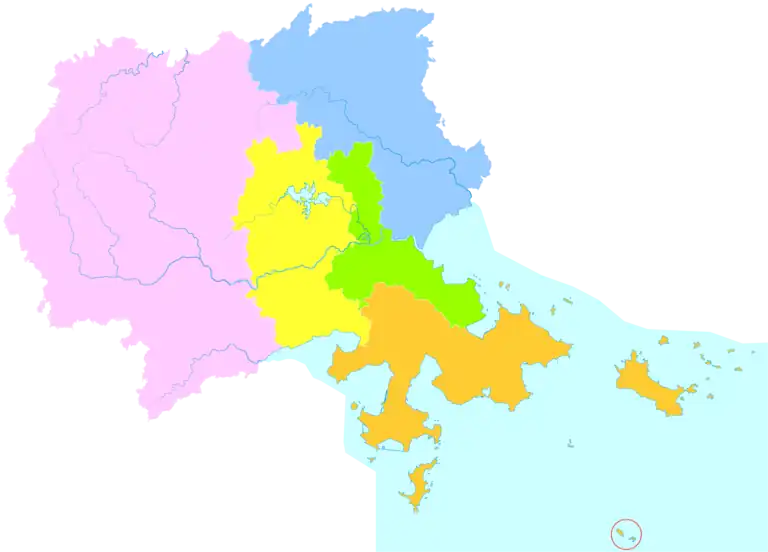Putian
Putian or Putien (Chinese: 莆田, Putian dialect: Pó-chéng), also known as Puyang (莆阳) and Puxian (莆仙), historically known as Xinghua or Hing Hwa (simplified Chinese: 兴化; traditional Chinese: 興化), is a prefecture-level city in eastern Fujian province, China. It borders Fuzhou City to the north, Quanzhou City to the south, and the Taiwan Strait's Xinghai Bay to the east.[4] The Mulan River flows through the southern part of the city.
Putian
莆田市 | |
|---|---|
Clockwise from top: Licheng District, Putian University, Guqiaolou Temple, Guanghua Temple in Chengxiang District, the Municipal Government building of Putian. | |
 Location of Putian in Fujian | |
 Putian  Putian | |
| Coordinates (Putian Government Plaza): 25°27′09″N 119°00′28″E | |
| Country | China |
| Province | Fujian |
| Municipal seat | Chengxiang District |
| Government | |
| • CPC Secretary | Lin Baojin |
| • Deputy Mayor | Li Jianhui |
| Area | |
| • Prefecture-level city | 4,119 km2 (1,590 sq mi) |
| • Urban | 2,284 km2 (882 sq mi) |
| • Metro | 2,284 km2 (882 sq mi) |
| Population (2020 census)[1] | |
| • Prefecture-level city | 3,210,714 |
| • Density | 780/km2 (2,000/sq mi) |
| • Urban | 2,305,646 |
| • Urban density | 1,000/km2 (2,600/sq mi) |
| • Metro | 2,305,646 |
| • Metro density | 1,000/km2 (2,600/sq mi) |
| Time zone | UTC+8 (CST) |
| Postal code | 351100 |
| Area code | 0594 |
| ISO 3166 code | CN-FJ-03 |
| GDP | 2015[2] |
| - Total | CNY 167.0 billion (US$25.70 billion) |
| - per capita | CNY 58,596 (US$9,014) |
| - Growth | |
| License Plate Prefixes | 闽B |
| Local variety | Puxian Min |
| Website | www |
| Putian | |||||||||||||||||||||||||
|---|---|---|---|---|---|---|---|---|---|---|---|---|---|---|---|---|---|---|---|---|---|---|---|---|---|
| Simplified Chinese | 莆田 | ||||||||||||||||||||||||
| Postal | Putien | ||||||||||||||||||||||||
| |||||||||||||||||||||||||
History
Putian was first founded as an administrative area in the year of 568 as a city county during the Chen dynasty.
Putian was later established as a military administered city in 979. Putian is known as the counterfeit sneaker capital with counterfeiters protected from internationally intellectual property law enforcement by the notoriously corrupt local courts.[5]
Language
Pó-chéng-uā (莆田话), a sub-dialect of Min Chinese is spoken.
Economy
Putian has become an export base for Fujian products. The main industries are shoe-making, brewing, electronics, garments, fruits, vegetables, machinery and electrical goods.[6] In particular, the area is known for high-quality counterfeits of shoes[7] and the domination of Chinese private healthcare.[8][9]
Culture
.jpg.webp)
Putian is known for Putian (Henghwa) cuisine, a unique style of cuisine that places a heavy emphasis on fresh seafood. Duotou clams, locally harvested around the village of Duotou, are particularly well known.
Tourism
Meizhou Island, most famous for being the legendary birthplace of the goddess Mazu, is located closely offshore of Putian. According to legends, Mazu in her earthly incarnation died on the seashore of Xianliang Harbor, in the coastal area of Putian, where Xianliang Mazu Temple hosts pilgrims from different Chinese provinces and from Taiwan, particularly for the ceremonies commemorating the goddess' death held in October.[10] Because of its hosting "the most sacred places for Mazu believers," Putian is known as "Mazu's hometown."[11]
Universities and colleges
- Putian University
- Meizhouwan Vocational Technology College
Climate
| Climate data for Putian (1991–2020 normals, extremes 1981–2010) | |||||||||||||
|---|---|---|---|---|---|---|---|---|---|---|---|---|---|
| Month | Jan | Feb | Mar | Apr | May | Jun | Jul | Aug | Sep | Oct | Nov | Dec | Year |
| Record high °C (°F) | 27.0 (80.6) |
31.1 (88.0) |
30.3 (86.5) |
32.0 (89.6) |
33.8 (92.8) |
35.6 (96.1) |
36.9 (98.4) |
36.7 (98.1) |
36.4 (97.5) |
33.5 (92.3) |
31.1 (88.0) |
28.4 (83.1) |
36.9 (98.4) |
| Average high °C (°F) | 16.4 (61.5) |
16.9 (62.4) |
19.3 (66.7) |
23.7 (74.7) |
27.2 (81.0) |
30.3 (86.5) |
33.1 (91.6) |
32.7 (90.9) |
30.8 (87.4) |
27.0 (80.6) |
23.3 (73.9) |
18.7 (65.7) |
25.0 (76.9) |
| Daily mean °C (°F) | 12.6 (54.7) |
12.9 (55.2) |
15.1 (59.2) |
19.5 (67.1) |
23.5 (74.3) |
26.7 (80.1) |
29.0 (84.2) |
28.7 (83.7) |
27.1 (80.8) |
23.4 (74.1) |
19.7 (67.5) |
15.0 (59.0) |
21.1 (70.0) |
| Average low °C (°F) | 10.1 (50.2) |
10.4 (50.7) |
12.4 (54.3) |
16.6 (61.9) |
20.7 (69.3) |
24.1 (75.4) |
26.0 (78.8) |
25.8 (78.4) |
24.5 (76.1) |
21.0 (69.8) |
17.3 (63.1) |
12.5 (54.5) |
18.5 (65.2) |
| Record low °C (°F) | 1.5 (34.7) |
4.1 (39.4) |
2.8 (37.0) |
9.1 (48.4) |
15.0 (59.0) |
16.2 (61.2) |
22.0 (71.6) |
21.5 (70.7) |
19.8 (67.6) |
13.2 (55.8) |
6.3 (43.3) |
1.8 (35.2) |
1.5 (34.7) |
| Average precipitation mm (inches) | 47.1 (1.85) |
73.2 (2.88) |
116.3 (4.58) |
123.9 (4.88) |
199.6 (7.86) |
274.0 (10.79) |
183.1 (7.21) |
251.3 (9.89) |
145.8 (5.74) |
57.3 (2.26) |
42.7 (1.68) |
37.3 (1.47) |
1,551.6 (61.09) |
| Average precipitation days (≥ 0.1 mm) | 8.0 | 10.6 | 15.1 | 14.3 | 15.8 | 15.6 | 9.9 | 13.3 | 8.8 | 4.9 | 5.8 | 6.9 | 129 |
| Average snowy days | 0.1 | 0 | 0 | 0 | 0 | 0 | 0 | 0 | 0 | 0 | 0 | 0 | 0.1 |
| Average relative humidity (%) | 71 | 74 | 76 | 76 | 79 | 82 | 77 | 77 | 71 | 65 | 67 | 66 | 73 |
| Mean monthly sunshine hours | 121.5 | 101.9 | 116.4 | 130.9 | 137.1 | 153.7 | 243.2 | 213.7 | 182.5 | 179.2 | 140.8 | 135.8 | 1,856.7 |
| Percent possible sunshine | 37 | 32 | 31 | 34 | 33 | 37 | 58 | 53 | 50 | 51 | 43 | 42 | 42 |
| Source: China Meteorological Administration[12][13] | |||||||||||||
Administration
Putian's municipal executive, legislature and judiciary are in Chengxiang District (城厢区). The municipal region comprises three other districts and one county:
- Hanjiang District (涵江区)
- Licheng District (荔城区)
- Xiuyu District (秀屿区)
- Xianyou County (仙游县)
| Map |
|---|

Wuqiu
Note: Kinmen County, ROC (Taiwan) is claimed by the PRC. |
References
- "China: Fújiàn (Prefectures, Cities, Districts and Counties) - Population Statistics, Charts and Map".
- 莆田市2015年国民经济和社会发展统计公报 (in Chinese). Putian Municipal Statistic Bureau. 2010-02-20. Archived from the original on 2016-02-01. Retrieved 2010-05-03.
- 教育部重編國語辭典修訂本. Retrieved 17 August 2019.
字詞 【莆田縣】 注音 ㄆㄨˊ ㄊㄧㄢˊ ㄒㄧㄢˋ 漢語拼音 pú tián xiàn
- Litchi City Putian Archived 2011-05-22 at the Wayback Machine
- Rechtschaffen, Daniel. "How China's Legal System Enables Intellectual Property Theft". thediplomat.com. The Diplomat. Retrieved 12 November 2020.
- China today Archived 2007-09-07 at the Wayback Machine
- Schmidle, Nicholas (2010-08-19). "Inside the Knockoff-Tennis-Shoe Factory". New York Times. Retrieved 8 September 2010.
- "The Putian phenomenon". Week in China. HSBC. 2014-06-20. Retrieved 5 May 2016.
- "Baidu's "moral dilemma" – How a Cancer Case aroused National Attention". China Spoon. 2014-06-20. Retrieved 5 May 2016.
- Hsun Chang, "Multiple Religious and National Identities: Mazu Pilgrimages across the Taiwan Strait after 1987," in Cheng-tian Kuo (Ed.), Religion and Nationalism in Chinese Societies, Amsterdam: Amsterdam University Press, 2017, 373–396 (378).
- Hsun Chang (2017), 378.
- 中国气象数据网 – WeatherBk Data (in Simplified Chinese). China Meteorological Administration. Retrieved 23 June 2023.
- 中国气象数据网 (in Simplified Chinese). China Meteorological Administration. Retrieved 23 June 2023.
.jpg.webp)



